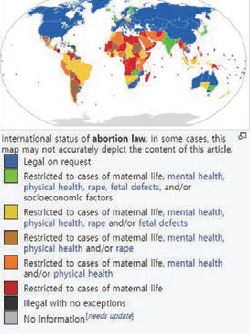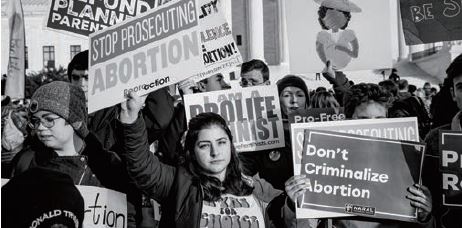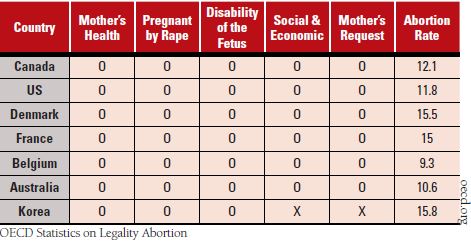On April 11th, the Constitutional Court of Korea ruled that the abortion ban was against the Constitution and called for an amendment. The ban against abortion has been a contentious issue ever since the first ruling of this case in 2012 that the abortion ban was not against the Constitution. Accordingly, the Sungkyun Times (SKT) will examine the status of abortion in the world and Korea, and present major issues and implications related to abortion.

Status of Abortion
Abortion is the act of artificially expelling a fetus before natural delivery. The ways in which abortion is carried out can vary, but the tolerance for legal abortion varies depending on the country.
Abortion in Foreign Countries

Many developed countries, such as the Netherlands and Sweden, allow abortions. Abortion is allowed in these countries at the woman’s request, usually within 12 weeks. On the other hand, countries in South America and the Middle East and Africa tend to allow abortion only under very restricted conditions. These countries usually have conservative views on abortion, mostly due to the influence of religion.
Abortion in Korea
In Korea, the law that punishes abortion was first enacted in 1953. In 2012, there was a constitutional ruling that abortion was not against the constitution. Seven years from then, the Constitutional Court made a new decision that called for an amendment on the ban of abortion. However, Korea still allows and will continue to allow abortion only on a limited basis, until December 21st, 2020. According to Articles 269 and 270 of the Criminal Act, women who have abortions and people who perform abortions should be punished. On the other hand, the Mother and Child Health Act, makes abortion possible within 24 weeks of pregnancy, if the mother is in danger of life or health, becomes pregnant through rape, or if the fetus has a genetic disease. The act, however, does not allow abortion for socio-economic reasons. Although Korea has relatively strong regulations on abortions, lots of abortions are still being carried out under-the-table. In fact, according to OECD (Organisation for Economic Co-operation and Development) statistics in 2018, Korea’s abortion rate is 15.8 for every 1,000 women aged 15-44, which is one of the highest in the OECD. In addition, the pros and cons of this issue are sharply divided, but many women tend to agree to abolishing punishment for abortion. According to the Minstry of Health and Welfare’s survey on abortion status, targeting 10,000 women aged 15-44, released in February this year, 75.4% of the respondents answered that there is a need to revise clauses on the Criminal Law on abortion punishment. Nevertheless, religious and pro-life groups in Korea actively oppose the abolition of the abortion punishment clause, claiming that fetuses also have the right to life.
Major Issues Surrounding Abortion
The Rights to Life Debate
The right to life is the most fundamental issue when it comes to abortion. In particular, the point of time at which the fetus is acknowledged as a person with the right to life, plays a vital role in determining whether to allow or ban abortion.
➊ Conservatism
Conservatism, in terms of abortion, is a side that considers fertilized eggs as beings with the right to life. One of the most significant groups in society that holds such a perspective is the Catholic Church. Catholicism argues that the fertilized egg has the potential to become human and that the fertilized eggs themselves have the right to life as human beings. From this perspective, killing fertilized eggs is regarded as an act of murder. This view is also on the same lines as the 2012 Korean constitutional ruling on abortion that acknowledged the life rights of the fetus. As a result, the majority of countries with strong ties to Catholicism often make abortion illegal except for in very exceptional cases. Furthermore, conservatives fear that abortion decriminalization will lead to a widespread trend of disregard for life. They argue that legalizing abortion by choice will lead people to make light of the preciousness of life. They also claim that the decriminalization, which will be followed by better access to abortion, will lead to more abortions and may even lead to commercialization of abortion.
➋ Libertarianism
Although there is a broad spectrum from a libertarianism perspective, the libertarianism perspective on abortion generally sees that the fetus has the right to life only after a particular period of pregnancy. Countries that allow abortions due to a woman’s choice, or for limited circumstances, take this position. There is, however, room for debate over at which point of pregnancy the fetus should be considered as having the right to life. While most of such countries allow abortion within 12 weeks of pregnancy, some countries allow abortion even after 20 weeks of pregnancy, depending on when the country sees the fetus as having the right to life.

Women’s Choice and Safety
Along with the right to life of the fetus, a woman’s choice and safety are the most controversial issues when it comes to abortion. Countries that allow abortion at the woman’s request prioritize a woman’s choice up to a certain point in time. In the United States (US), abortion became legal in all states after the ruling of the Roe v. Wade case in the Federal Supreme Court. The court stated that abortion should be allowed within 24 weeks of pregnancy according to a woman’s choice. The main reason for such a decision was that the fetus, within 24 weeks of pregnancy, cannot be seen as an independent being that can survive independently of the women’s body; thus during this period, women should be able to have an abortion through their own free will. Furthermore, in Korea, people who are against punishing women who have abortions argue that the punishment not only limits women’s choices but also hinders women’s safety. Under the current law, if a woman has an abortion, the operation is conducted illegally without medical supervision. The lack of oversight can leave women unprotected from surgeries that may go wrong.
Implications of Abortion Debate
Practical Guidelines and Education
Whether abortion is legal or illegal, it seems that abortion will not disappear as long as unwanted pregnancies exist. That is why practical guidelines and instructions on abortion are needed to ensure health rights and the safety of the public. Since abortion is illegal in Korea, most people often get counseling about abortion on the Internet rather than consulting professional doctors. Therefore, national level intervention is necessary to gradually resolve the health and safety rights problems that result from inaccurate information on abortion. If the government publicly provides information about abortion to the public, it will at least help prevent dangers that occur due to erroneous information about abortion. The government can also alert the public about the possible dangers and side effects of abortion. Furthermore, it is necessary to help individuals form healthy perspectives on abortion by ensuring quality education on abortion within formal school education. In reality, however, the National Sexual Education Standard Plan does not contain contents regarding abortion in middle school sex education. Therefore, the government needs to provide sufficient education on abortion and to facilitate access to relevant information, considering the reality of abortion. Also, schools should teach students the responsibility for life. By promoting awareness of life, people might better understand the consequences of their actions, which may indirectly help reduce the number of abortions carried out in the country.
Promoting Contraception
The government needs to encourage people to use contraception methods, such as condoms, to lower unwanted pregnancies. Korea is one of the OECD countries with the lowest contraception rates. Therefore, to prevent reckless abortions, practical education and other measures are needed to encourage contraception and increase access to various contraception methods. Another way to avoid unwanted pregnancies is by using post-coital contraception pills. In Korea, Ellaone and Norlevo are the pills that can be legally prescribed. These pills are currently classified as prescription medicines. Many argue for the need to re-classify these pills to over-the-counter medicines that do not need a doctor’s prescription. They reason for better accessibility to the pills, which are more effective when they are taken within a short period after sexual intercourse because it could result in reducing surgical abortion and illicit drugs. From a conservative’s point of view, however, the fertilized eggs themselves are also beings with the right to life, and any form of intervention that disturbs their becoming human, including contraceptives, may be considered equivalent to surgical abortion.
Social and Economic Factors

Social and economic reasons, or personal reasons, are factors that better explain the practice of abortion than legal restrictions do. In fact, restrictions on abortions do not have much correlation with abortion rates. OECD statistics on legality of abortions and abortion rates clearly show that developed countries that allow abortions, such as the Netherlands and Australia, have lower abortion rates than Korea does. What these countries have in common is that they have better welfare that supports parents with children. Therefore, forming an environment where social and economic reasons do not deter parents to give birth is the most fundamental solution for reducing abortion. Korea places most of its responsibilities of child care on parents. The concerns over the career break due to giving birth and the overwhelming social and economic responsibilities, have led people to shy away from giving birth. According to the Ministry of Health and Welfare’s statistics on abortion status in 2018, about half of the respondents that had abortions answered that they had abortions due to social and economic reasons. The result shows the need for solving the fundamental causes of abortion before focusing on punishment.
No matter the decision of the Constitutional Court, both the pros and cons of the abortion ban do have sound arguments. One side emphasizes the right to life and the value of life, while the other highlights the free choice of women to have an abortion. Although constitutional rulings may have put more weight on the latter, it is important to note that both sides’ arguments must be respected. The SKT hopes that the nation has ample discussions on abortion and comes up with a consensus for the amendment.
